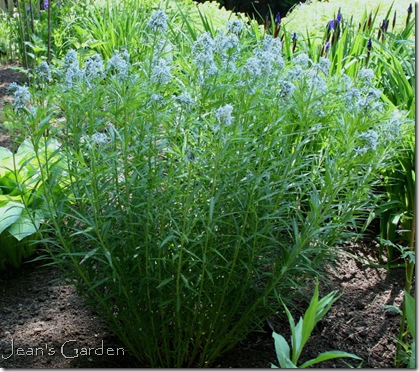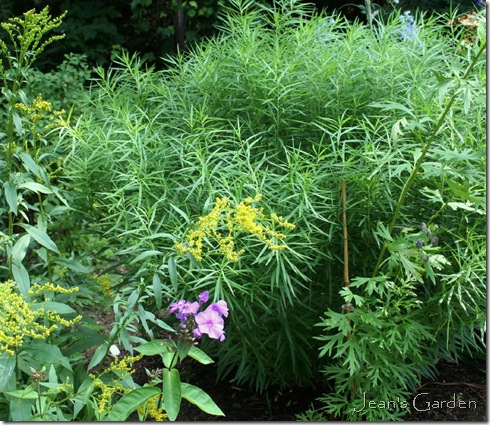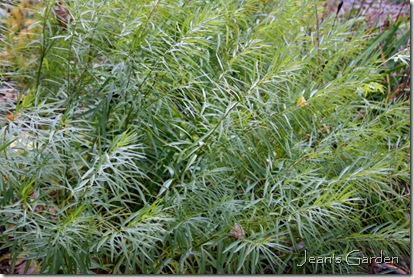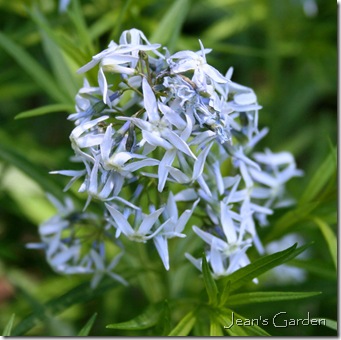Amsonia: A Star in the Garden
October, 2015: For Those who have come here from blessmyweeds.com, the information about Amsonia on that website is completely wrong. I hope that this post will provide you with a better understanding of how to use Amsonia in your garden.
 When I first planted Amsonia in my garden, I had never seen it growing anywhere; I chose it solely on the basis of a description in Rodale’s Illustrated Encyclopedia of Perennials (Rodale Press, 1993). Not only did it’s common name of “Blue Star Flower” make it a natural for my blue and yellow border; I was also very taken with Rodale’s description of it as an architectural plant that “add[s] structure to the perennial garden.”
When I first planted Amsonia in my garden, I had never seen it growing anywhere; I chose it solely on the basis of a description in Rodale’s Illustrated Encyclopedia of Perennials (Rodale Press, 1993). Not only did it’s common name of “Blue Star Flower” make it a natural for my blue and yellow border; I was also very taken with Rodale’s description of it as an architectural plant that “add[s] structure to the perennial garden.”
Amsonia is a small genus of North American native plants. A. tabernaemontana is the best plant for northern gardens, cold hardy to USDA zone 3. Several other species are native to the southeastern part of the United States; these include A. ciliata (Downy Amsonia), A. hubrichtii (Arkansas Amsonia) and A. ludoviciana (Louisiana Blue-Star Flower). There is also a species (A. orientalis) that is native to southern Europe.
I am very happy that I learned about this genus in time to include it in the design for my blue and yellow border, because it has been a constant source of delight in the garden. Amsonia marks the beginning of early summer in my garden each year, opening its first flowers in late May or early June and continuing to bloom for about a month. I do sometimes wish that the flowers, which are so pale as to be almost white, were a deeper blue; but the beautiful foliage more than compensates for any disappointment about the color of the flowers. My single plant has grown to a clump that is about 4’ in diameter. Throughout the summer, long after its blooms have faded, Amsonia is a striking presence, with graceful foliage that provides a lovely backdrop for the blooms of other plants. As summer turns to fall, that foliage becomes still more beautiful, turning from bright green to a soft green-gold and then to a bright autumn gold. 
| xx |
 For many years, I thought the Amsonia growing in my garden was the most cold-hardy species, A. tabernaemontana. After looking at the descriptions and images on the plant finder database at the Missouri Botanical Garden website, however, I have become convinced that my plant is actually A. hubrichtii, which is characterized by its pale flowers and feathery foliage. Armitage (Herbaceous Perennial Plants, 2nd edition) rates this species for USDA zones 6-9, but the Missouri Botanical Garden considers it cold hardy to zone 5 (which makes it a good candidate for my garden). Whichever plant I have, it is very much a star of the perennial border. As I develop new planting areas, I’m looking forward to adding more Amsonia to my garden, including two varieties whose flowers are a more pronounced blue, A. tabernaemontana and the cultivar ‘Blue Ice.’
For many years, I thought the Amsonia growing in my garden was the most cold-hardy species, A. tabernaemontana. After looking at the descriptions and images on the plant finder database at the Missouri Botanical Garden website, however, I have become convinced that my plant is actually A. hubrichtii, which is characterized by its pale flowers and feathery foliage. Armitage (Herbaceous Perennial Plants, 2nd edition) rates this species for USDA zones 6-9, but the Missouri Botanical Garden considers it cold hardy to zone 5 (which makes it a good candidate for my garden). Whichever plant I have, it is very much a star of the perennial border. As I develop new planting areas, I’m looking forward to adding more Amsonia to my garden, including two varieties whose flowers are a more pronounced blue, A. tabernaemontana and the cultivar ‘Blue Ice.’
If you are looking for a lovely, easy-care plant that will add both starry flowers and star power to your garden, consider Amsonia.


Yeah! I love this plant and was lucky enough to find some at a local farm stand / nursery this fall. I had a spot all ready for it in my new bed. I hope to order more (from Amanda’s Garden) for spring delivery as I would like a BIG DRIFT of this wonderful plant. Seeing yours looking so gorgeous makes me happy even more so with this choice. And it also makes me look forward to spring – already!
After reading your post I found my copy of Rodale’s Illustrated Perennials (such a great go to book!) and looked up Amsonia. What a wonderful plant. I love how you included photos of it throughout the season. The book talks about it as a great structural plant but your photographs really illustrate that point.
I have the Rodale book, guess I had better open it up again! I will certainly look for this plant in the spring.
Eileen
Hi Jean, I have long had this plant on my wish list, and had only heard of the hubrichtii – thanks for the education. I want whatever they have at the Lurie Garden in Chicago – the color was blazing yellow last month!
Between the gentle blue flowers and the golden foliage, perhaps a backdrop of a darker leaved shrub to set it off?
I’ve never seen this plant Jean, thank you for highlighting it, it’s lovely!
I really like the foliage of this plant, and the color of the blooms is lovely. Good information. Now I know there are amsonias that are native to the southeast where I am. I will have to check them out!
I have just finished reading a gardening book that lists Amsonia as one of the top ten spring blooming perennials. I had avoided planting it in the past because the flower color is so pale. After seeing it on the “list” I relented and added to my perennial order for next season. And the next day, voila, there it is again, but this time in your blog. What a coincidence!
Thanks for the info. i also use the Mo. site. We are always looking for new plants. Somehow there is always room. jim
I have amsonia in my gardens. The original plant came from Caprilands Herb Farm in Coventry, CT. I saw it there and fell in love. That was about 20 years ago. The four amsonia I currently have all grew from one plant. They have survived transplant after transplant but all bounced back well and thrived. Few gardeners use amsonia … more should. It’s hardy, trouble free, transplants well, blooms profusely, is winter hardy, and turns a lovely golden yellow in autumn.
Jean – thanks for sharing the information on this plant. The leaf structure, plant height and pale white-blue blooms won me over — I just added it to my wishlist in my garden journal!
It has a fantastic form, Jean. I love that you let us see the whole plant, and not just the flower, and tell us how it performs for you. This kind of intimate and honest plant portrait is one of the reasons I so enjoy your blog. 🙂
I love these plants, and have three kinds: hubrichtii, taebermontana, and a little cultivar called ‘Blue Ice’ that stays low and gets very deep blue flowers, but has the same lance shaped fluttery leaves as the bigger ones. They take a while to get going; I have found that they need three years to start filling in. My feathery hubrichtii, just two years old, flops all over the ground now but I am hoping it gets big and bushy by next year. Fall color is outstanding. You’ve highlighted a great plant!
Hi Jean, once again a good idea from your blog. Amsonia is available here in Europe as well. I hope it wouldn’t be a sin to plant it as a non-native species, since you make it sound very tempting and attractive.
Now to track it down in South Africa! Was any mention made of how easy it is to propagate from seed in your readings, Jean?
Hello Everyone, I’m sorry I’ve been slow to respond; it’s grading crunch time, when I must spend many, many hours each day reading student papers.
VF, Thanks for the reference to a source of these plants; I just checked the Amanda’s Garden website, and they have a great selection of plants (at great prices). I’m starting to think that a hedge of Amsonia in a raised bed might be just the thing to separate my clothesline area from the new “secret garden” area.
Marguerite and Eileen, I think the Rodale book was the first guide to perennials I every bought; mine is very well-thumbed (although I tend to switch to Armitage when I want more detailed information).
Cyndy, I looked at the Lurie Garden website, and they are growing several Amsonia varieties. They specifically mention the cultivar ‘Blue Ice’ as having spectacular fall color, and they show photos of golden foliage of A. hubrichtii. If the plant you saw was taller (2 1/2 – 3′) and more feathery, it was probably hubrichtii; if it was shorter and more willowy, it was probably ‘Blue Ice.’
Diana, What a great suggestion!
Clare, We garden in such different climates, it’s not surprising that the plants we know and love are also different.
Deb, These are mostly native to the southeast; I bet they would be very happy in your garden.
Allan, I just learned after I wrote this post that Amsonia had been named “plant of the year” for 2011, so I guess awareness of it is on the rise. Even though it’s not a flashy plant, its gentle beauty can have a big impact. You’ll have to let me (and your readers) know what you think after you’ve tried it.
Jim, I’m glad to know that someone else out there is a fan of the Mobot site. Of course, they only list plants that they are growing in the botanical gardens; but since they grow a lot of plants and since I can grow most of what they grow, it works for me.
Joene, I bet another reason (which I forgot to mention in my post) why you love these plants is that they are pretty deer resistant. I’d love to hear more about how you propagated yours. One source I looked at said that they’re pretty hard to divide because the root ball is so woody and recommended leaf cuttings. Jack wonders how easy it is to propagate them from seed. What was your experience?
Shyrlene, How nice to share a plant I love and have someone else be wowed by it, too.
Thanks, Meredith; I’m always happy to share my plant loves!
Laurrie, The three you are growing are the same three I want in my garden. I almost wrote that Amsonia doesn’t flop (because mine never has), but then I did some additional reading and found that they do flop under some conditions (like less sunlight).
Barbara, I’m not a natives-only gardener; my garden is a mixture of native plants and exotics. It’s probably a good idea to check invasive plant lists for your area to make sure none of these is a problem. But even if one species were a problem, I bet there would be others that were not (especially since there are a couple European-native species in the genus).
Jack, I found one (seemingly authoritative) source (http://www.rickdarke.com/Amsonia.pdf) that said Amsonia could be grown from seed sown over the winter or in early spring and that they require cold treatment for germination. Fine Gardening’s web site (http://www.finegardening.com/plantguide/amsonia-hubrichtii.aspx) recommends sowing seed in containers in spring or fall.